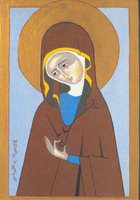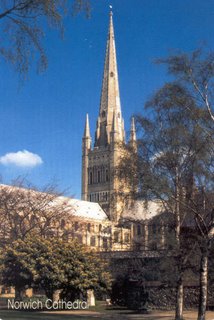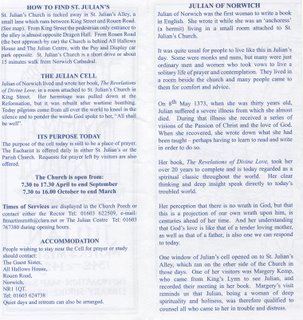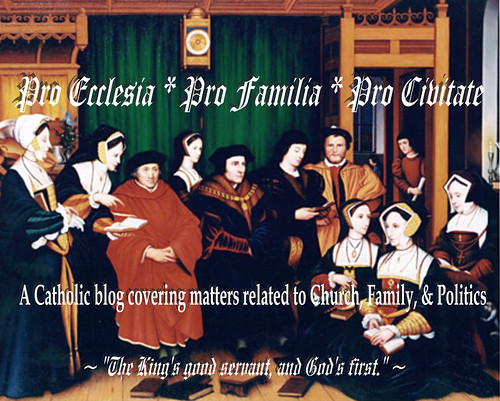Julian of Norwich, 13 May
"All shall be well, and all shall be well, and all manner of things shall be well."
~ Julian of Norwich
 Text from the Medieval Saints Yahoo Group (postcards and photos from my visit to Norwich, England last fall):
Text from the Medieval Saints Yahoo Group (postcards and photos from my visit to Norwich, England last fall):Blessed Juliana of Norwich, Benedictine, mysticMy Comments:
Also known as Julian of Norwich
Died c. 1423 of natural causes in Norwich, England
Not officially beautified
Commemorated May 13
Her book, "Revelations of Divine Love," which contains sixteen revelations she received while in an ecstatic trance, is still in print.
Blessed Juliana of Norwich, OSB Hermit (PC)
http://www.saintpatrickdc.org/ss/0513.htm#juli
Born c. 1342; died in Norwich, England, c. 1423; she has never actually been beatified.Among the English mystics none is greater than the Lady Julian, who lived near Norwich, England, in a three-roomed hermitage in the churchyard of Conisford. Absolutely nothing is known of her life before becoming an anchorite. In fact, we do not even know her name; she has been given the name of the church where she had her cell. An old English historian writes: "In 1393, Lady Julian, the anchoress here was a strict recluse, and had two servants to attend her in her old age. This woman was in these days esteemed one of the greatest holiness."
She lived in an age of startling and confusing contrasts. It was the time of the Black Death, the Peasants' Revolt, Piers Plowman and Wat Tyler, when the old social patterns were breaking down. But none of this is reflected in her quiet and retired life or in the pages of her spiritual autobiography, Revelations of Divine Love, which is the most sublime of all expositions of its kind in English. Her masterpiece encompasses the love of God, the Incarnation, redemption, sin, penance, and divine consolation."These revelations," she writes, "were shown to a simple creature unlettered, the year of our Lord 1373, the eighth day of May." She desired above all to know the suffering of our Lord -- what she called "the mind of His Passion"--and that nothing might stand between herself and God. She tells us that when at the age of 30 she
was at the point of death and the curate was sent for to administer the last rites, "he set the Cross before my face and said: 'I have brought you the Image of thy Maker and Savior: Look thereupon and comfort yourself with it.'"
She spent the next 20 years meditating upon the 16 revelations that followed in a state of ecstasy, of Christ's Passion and the Trinity. She saw the red blood flow from under the Crown of Thorns; she saw the Virgin, a young and simple maid; she saw our Lord a 'homely loving.' Then God showed her a little thing--a hazel nut in the palm of her hand. She thought: what may this be? and was answered: "It is all that is made. God shaped it. God gave it life. God maintains it."
Thus, she learned the goodness of God, in which is our highest prayer and which "comes down to our lowest need." And still regarding the Crucifix, she saw the stream of God's mercy falling like showers of rain, and looked upon the tokens of His Passion. She saw our Lord dying and underwent the torments and agony of His suffering. "And thus I saw Him, and sought Him; I had Him and I wanted Him." It seemed, she said, as if He were seven nights dying, so outdrawn was His anguish, suffering the last pain, seven nights dead, continually dying, in a cold dry wind. "Thus was I taught to choose Jesus for my Heaven, whom I saw only in pain at that time . . . to choose only Jesus in good times and bad. . . . He shall make all well that is not well. . . . Prayer unites the soul to God."
In this way, this remarkable book pursues its course, full of deep insight and feeling: "In Christ our two natures are united." "Our soul can never have rest in things that are beneath itself." "God can do all that we need." "I knew well that while I beheld in the Cross I was surely safe." And its last word is: "Love was our Lord's meaning." At the time of her death she had a far-spread reputation for sanctity, which attracted visitors from all over England to her cell (Benedictines, Delaney, Gill).
-------------------------
More on Blessed Juliana at:
http://www.newadvent.org/cathen/08557a.htm
http://www.stthomasirondequoit.com/SaintsAlive/id761.htm
 My family visited the city of Norwich during our pilgrimage to England last September. Norwich is the best preserved medieval city in England. In addition to the beautiful medieval Norwich Cathedral (now Anglican), the city literally has a church on every street corner - with over 30 medieval churches and the 19th Century Gothic revival St. John the Baptist Roman Catholic Cathedral, which was a gift to the Diocese of Norwich by Henry Fitzalan Howard, the 15th Duke of Norfolk. During our trip, we met one man from Norwich who joked that the city had 52 churches - one for every week of the year, and 365 pubs - one for every day of the year.
My family visited the city of Norwich during our pilgrimage to England last September. Norwich is the best preserved medieval city in England. In addition to the beautiful medieval Norwich Cathedral (now Anglican), the city literally has a church on every street corner - with over 30 medieval churches and the 19th Century Gothic revival St. John the Baptist Roman Catholic Cathedral, which was a gift to the Diocese of Norwich by Henry Fitzalan Howard, the 15th Duke of Norfolk. During our trip, we met one man from Norwich who joked that the city had 52 churches - one for every week of the year, and 365 pubs - one for every day of the year. One of our favorite Norwich churches, tucked in an out-of-the-way corner of the city, was St. Julian's Church - containing the Shrine of St. Julian on the site of the former cell of the famous anchoress and mystic Julian of Norwich. Below is a photo I took of the site of Julian's cell.
One of our favorite Norwich churches, tucked in an out-of-the-way corner of the city, was St. Julian's Church - containing the Shrine of St. Julian on the site of the former cell of the famous anchoress and mystic Julian of Norwich. Below is a photo I took of the site of Julian's cell.
Julian is included among the English saints in this painting of Our Lady of Walsingham and the English Saints (see if you can locate her):

Finally, below is a copy of a brochure that we picked up while visiting St. Julian's Church:


UPDATE (16 May 2006)
Here's a story on Blessed Julian of Norwich from the BBC.
(Hat tip: Stix Blog)



3 Comments:
Ring out, bells of Norwich,
And let the people come and go.
All shall be well again. I know.
All shall be well, and all shall be well and all manner of things shall be well.
Did you really need to convert to Roman Catholism to enjoy the readings and beliefs of people such as (Saint) Thomas More and Julian of Norwich and all the rest of the mystiques?
I do not understand the need to commit to a particular Christian dogma in order to take to heart what the mystiques wrote. I am not Roman Catholic nor do I need to convert to this very antiquated religion to adhere to the writings of the mystiques; the illuminations of their spirituality is enough for me.
Remember, these people lived in a time before any other 'confirmed' Christian theology; the Church of Rome was primarily "it". Who is to say they wouldn't have had these "experiences" if they had been non-Roman Catholic?
Sir Thomas More is one of my champions; not because he was a Roman Catholic but because he chose, to the end, to uphold his beliefs, and this should be the very reason he goes down in history as an outstanding human being, not because he was beatified by the Roman Catholic Church.
More was a lawyer, a writer, a translator, a statesman, a parliamentarian of the highest order and, above all, a simple, honest, upstanding person ... and, yes, he was also a devout Roman Catholic but his beliefs in Roman Catholism is not his only trait he should be remembered by.
What I am saying, simply, is there is no need to convert to another religion in order to study, believe and live by the examples of others, regardless of what their religious convictions are (or were).
Post a Comment
<< Home